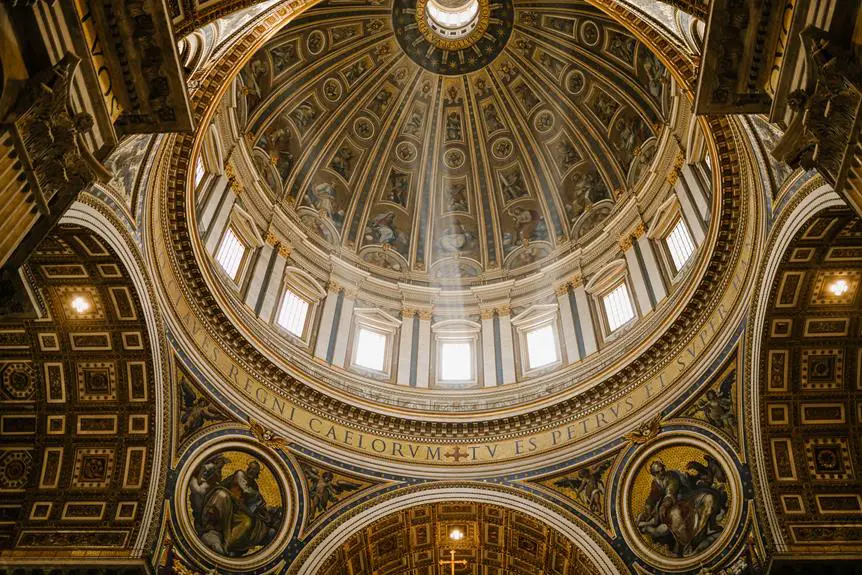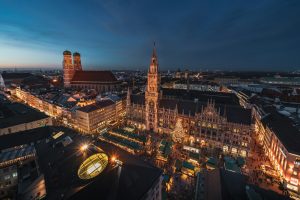Nestled in the heart of Italy, Rome stands as a testament to the grandeur of human civilization. Its storied past, adorned with ancient ruins and architectural marvels, weaves a timeless tapestry of history, art, and culture.
From the awe-inspiring Colosseum to the intricate masterpieces of Renaissance artists, Rome's treasures are abundant and captivating.
But beyond its artistic allure, Rome invites us to embark on a culinary journey, tantalizing our taste buds with its gastronomic treasures.
And as we delve deeper into the city's vibrant traditions and immerse ourselves in its rich cultural heritage, we find that Rome's allure extends far beyond its ancient glory.
Indeed, Rome is a city that seamlessly blends its illustrious past with its contemporary charm, leaving us with a sense of wonder and an insatiable desire to uncover more.
Ancient Ruins: Uncovering Rome's Glorious Past
Unveiling the remnants of a bygone era, Rome's ancient ruins stand as vivid testaments to the city's illustrious history and captivating past. As one explores the streets of Rome, it becomes evident that the city is a living museum, with archaeological discoveries and preserved artifacts at every turn.
The ancient ruins of Rome provide a glimpse into the grandeur of the Roman Empire. The Colosseum, an iconic symbol of the city, is a magnificent amphitheater that once hosted gladiatorial contests and spectacles. Its towering arches and colossal structure are awe-inspiring, reminding visitors of the power and influence the Romans held.
Another remarkable archaeological find is the Roman Forum, a sprawling complex of temples, basilicas, and government buildings. This was the heart of ancient Rome, where politics, commerce, and religion converged. Walking through the ruins, one can imagine the bustling activity that once took place in this agora.
Preserved artifacts further enrich the experience of Rome's ancient ruins. The Vatican Museums house an extensive collection of Roman sculptures, mosaics, and frescoes. These masterpieces offer a glimpse into the artistic achievements of the ancient Romans.
Renaissance Art: Exploring Rome's Masterpieces
What artistic treasures await in Rome's Renaissance masterpieces?
Rome is home to an array of magnificent Renaissance art that showcases the skill and creativity of renowned artists from this period. From the grandeur of Michelangelo's Sistine Chapel ceiling to the delicate brushstrokes of Raphael's frescoes in the Vatican Museums, these masterpieces continue to captivate visitors with their beauty and significance.
Exploring these works allows us to delve into the techniques employed by these artists and understand the impact they had on the art world. The use of perspective, chiaroscuro, and naturalistic depictions were all innovative concepts introduced during the Renaissance. Artists such as Leonardo da Vinci and Caravaggio pushed the boundaries of artistic expression, creating lifelike portraits and dramatic scenes that still resonate today.
Furthermore, Rome's Renaissance masterpieces have had a profound influence on subsequent generations of artists. The works of Michelangelo, for example, inspired countless artists to strive for perfection and push their own artistic boundaries. The influence of these masterpieces can be seen in the art and architecture of later periods, as well as in the techniques and styles adopted by artists worldwide.
Culinary Delights: Indulging in Rome's Gastronomic Treasures
Rome's artistic legacy extends beyond its Renaissance masterpieces, as the city's gastronomic treasures offer a sensory journey that is equally captivating and unforgettable. Rome is not only known for its historical landmarks but also for its delectable cuisine that has been passed down through generations. The city is a paradise for food enthusiasts, with its abundance of food festivals and traditional recipes that showcase the rich culinary heritage of Rome.
One of the highlights of Rome's culinary scene is its vibrant food festivals. These festivals celebrate the diverse flavors and ingredients that make Roman cuisine so unique. From the Festa de' Noantri, which showcases traditional Roman dishes such as pasta alla gricia and abbacchio, to the Sagra del Carciofo Romanesco, dedicated to the artichoke, these festivals offer a chance to indulge in a wide variety of mouth-watering dishes.
Traditional recipes play a significant role in Rome's gastronomic treasures. Passed down from generation to generation, these recipes are a testament to the city's rich culinary history. Carbonara, a classic Roman pasta dish made with eggs, cheese, pancetta, and black pepper, is a must-try for any visitor. Another iconic dish is Cacio e Pepe, a simple yet flavorful pasta dish made with Pecorino Romano cheese and black pepper.
In Rome, every meal is an opportunity to explore the city's culinary delights. Whether savoring traditional recipes or indulging in the festivities of food festivals, Rome's gastronomic treasures are sure to leave a lasting impression on every visitor.
Cultural Immersion: Experiencing Rome's Vibrant Traditions
Immerse yourself in the vibrant traditions of Rome, where centuries-old customs and cultural practices come alive in a city steeped in history and heritage.
Rome is renowned for its traditional festivals and local customs, which offer visitors a unique opportunity to experience the rich tapestry of Roman culture.
One of the most iconic festivals in Rome is the Carnival, held annually in February. This lively event features colorful parades, masked balls, and street performances, reminiscent of the city's ancient Roman roots. The streets come alive with music, dance, and laughter as locals and tourists join together in celebration.
Another significant tradition in Rome is the Festa della Primavera, or Spring Festival, held in April. This festival marks the arrival of spring and is characterized by vibrant flower displays, street markets, and outdoor concerts. It is a time when the city bursts with color and joy, as Romans embrace the beauty of the season.
In addition to these festivals, Rome is known for its local customs, such as the traditional Sunday family lunch. Romans take great pride in their culinary heritage, and Sunday lunch is a cherished time for families to come together and enjoy a leisurely meal. This tradition highlights the importance of family and community in Roman culture.
To truly immerse yourself in Rome's vibrant traditions, be sure to participate in these traditional festivals and embrace the local customs. By doing so, you will gain a deeper understanding and appreciation for the rich cultural heritage that makes Rome such a captivating city.
Modern Marvels: Witnessing Rome's Contemporary Charms
Rome's contemporary charms are a testament to the city's ability to seamlessly blend the past with the present, offering visitors a glimpse into its vibrant and dynamic modern culture.
One of the most striking aspects of Rome's modernity is its contemporary architecture, which stands in stark contrast to its ancient landmarks. Marveling at Rome's modern skyline is a treat for architecture enthusiasts. The city boasts impressive skyscrapers, such as the EUR Tower and the Maxxi Museum, designed by renowned architects like Massimiliano Fuksas and Zaha Hadid. These architectural wonders showcase Rome's commitment to innovation and its embrace of modern design.
In addition to its architectural marvels, Rome has also made significant contributions to the fashion and design industry. Throughout history, Rome has been a center of fashion and style, and its influence can still be felt today. The city is home to world-renowned fashion houses and designers, who continue to shape the industry with their unique creations. From high-end fashion brands to independent boutiques, Rome offers a diverse and thriving fashion scene. Visitors can explore the city's fashion districts, such as Via dei Condotti and Via del Governo Vecchio, to discover the latest trends and immerse themselves in Rome's fashion culture.
Rome's contemporary charms, from its modern architecture to its influence on the fashion industry, offer a fascinating juxtaposition to its ancient heritage. It is a city that effortlessly combines the old and the new, creating a captivating tapestry of history, art, and culture.
Frequently Asked Questions
What Is the Best Time of Year to Visit Rome?
The best time to visit Rome is during the spring and fall seasons when the weather is mild and the crowds are smaller. This allows for a more enjoyable experience exploring the city's rich history, art, and culture.
Are There Any Specific Dress Codes to Be Aware of When Visiting Religious Sites in Rome?
When visiting religious sites in Rome, it is important to dress appropriately out of respect for their cultural significance. Modest attire, covering shoulders and knees, is generally required. It is recommended to avoid wearing revealing or offensive clothing.
How Do I Get From the Airport to the City Center?
When traveling to Rome, there are various options for airport transportation to the city center. Public transportation, such as buses and trains, provide convenient and cost-effective ways to reach your destination, allowing you to explore the vibrant city upon arrival.
Are There Any Famous Movies or TV Shows Filmed in Rome?
Rome, with its rich history and stunning architecture, has served as a backdrop for numerous famous movies and TV shows. From iconic movie scenes set in Rome to famous film locations, the city has captivated audiences with its timeless beauty.
Can You Recommend Any Off-The-Beaten-Path Attractions or Activities in Rome?
When exploring Rome, don't miss the hidden gems that offer a unique experience. From the tranquil Aventine Hill gardens to the vibrant Trastevere neighborhood, immerse yourself in local culture and savor authentic Italian cuisine.
Conclusion
In conclusion, Rome offers a captivating journey through time, art, and culture.
The ancient ruins reveal the city's glorious past, while the Renaissance masterpieces showcase its artistic genius.
Indulging in Rome's gastronomic treasures allows for a sensory experience like no other.
Immersing oneself in the vibrant traditions provides a deeper understanding of the city's rich cultural heritage.
Lastly, witnessing Rome's contemporary charms showcases the city's ability to blend its ancient roots with modern innovations.
Rome truly encompasses a timeless tapestry of history, art, and culture.






